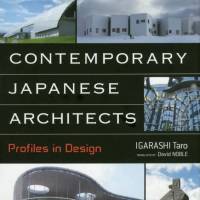In "Contemporary Japanese Architects," readers are offered a sweeping overview of 18 of Japan's most notable contemporary architects and firms. Part personal profile and part architectural treatise, each section situates their designs within the larger picture of Japanese culture, society and economy.
Contemporary Japanese Architects: Profiles in Design, by Taro Igarashi, Translated by David Noble.
303 pages
JPIC, Nonfiction.
The book opens with architectural giant Kenzo Tange (1913-2005) and his search for a "new architecture for Greater East Asia." This search often manifested as urban planning, whether as Tange's own "A Plan for Tokyo 1960" or his contemporary Kisho Kurokawa's (1934-2007) Buddhist-influenced theory of metabolism: an architecture that exists in a constant state of construction and destruction.
Each generation had its own architectural challenges to grapple with: the reconstruction of Japan's cities following World War II, the surplus of extravagant construction in the bubble economy or the fiscal realities in a post-bubble Japan, and these are addressed throughout.
Igarashi touches on most of Japan's "starchitects," from Tadao Ando, Terunobu Fujimori, Sanaa and Kengo Kuma to Junya Ishigami and Atelier Bow-Wow, and analyzes how their visions and designs adapt to Japan's ever-changing needs. Many younger architects, Ishigami in particular, push at the boundary between "art" and "architecture."
In closing with the Great East Japan Earthquake, Igarashi speculates on the role Japanese architects could play in reshaping the region. Whatever the result, it promises to be innovative.



















With your current subscription plan you can comment on stories. However, before writing your first comment, please create a display name in the Profile section of your subscriber account page.